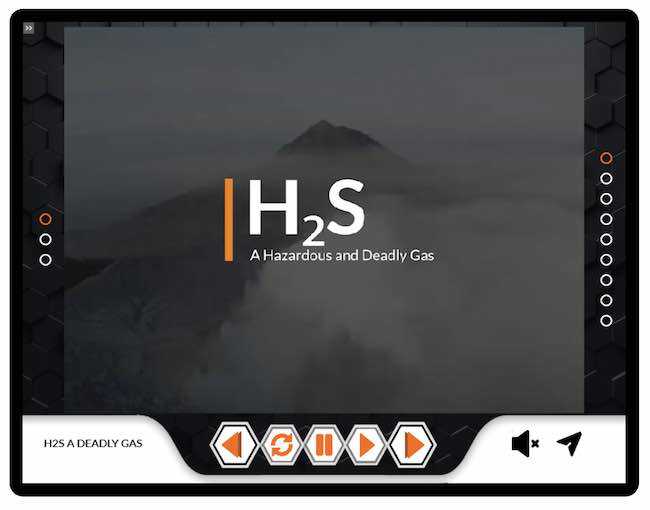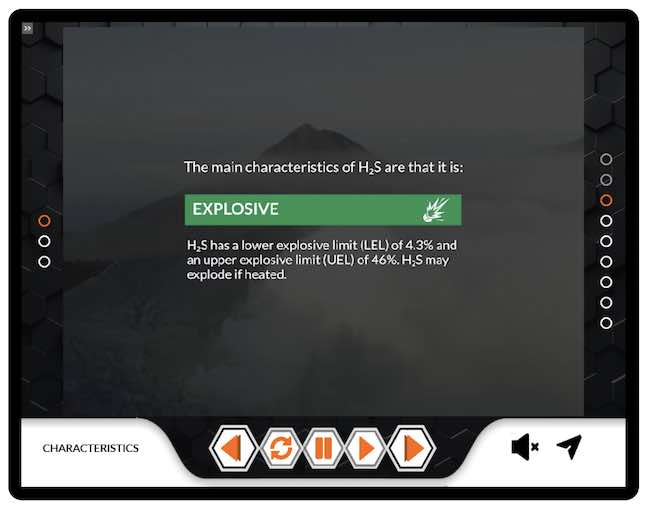Your basket is currently empty!

H2S Awareness Course
This online H2S course provides the knowledge needed to work safely by raising awareness of the dangers of H2S, providing an understanding of how to recognise unsafe levels of H2S in the atmosphere and the actions to take if H2S levels are unsafe.
- For Me
- For Teams
H2S AWARENESS
H2S Awareness training courses are important for those working is Hydrogen Sulphide (H2s) risk areas because H2S is one of the most dangerous gases that can be encountered in the workplace.
It is a by-product of many industrial processes including petroleum refining, tanning, mining, wood pulp processing, rayon manufacturing, sugar-beet processing, and hot-asphalt paving.
At low concentrations H2S is colourless and has the odour of rotten eggs. At high concentrations it is flammable and highly toxic. 1 or 2 breaths can render a victim unconscious.
In the UK many workplace deaths have occurred as result of H2S exposure. It is therefore vital that staff understand the risks and control measures appropriate to theHSE environment are in place.
This online H2S Awareness training is designed for everyone working in zones where H2S gas could be present and exceed Workplace Exposure Limits. The course provides the knowledge need to identify if H2S is present and subsequently what to do in order to keep themselves and co-workers safe.
This Hydrogen Sulphide (H₂S) online Awareness training can be used in place of traditional classroom training to help achieve a safe work environment where H₂S hazards are present.
LEARNING OBJECTIVES
On completion of the online H2S Awareness training course learners will know;
- Why H2S is highly dangerous
- The risks to health associated with H₂S
- Understand where H₂S can be found
- The workplace exposure limits (WEL)
- Personal Safety Measures
- Team Safety Considerations
COURSE CONTENT
UNIT 1 | INTRODUCTION TO HYDROGEN SULPHIDE
UNIT 2 | H2S IN DETAIL
UNIT 3 | H2s CONTROL MEASURES
H2S CERTIFICATES
At the end of the accredited online H2S Awareness course there is a 12 question, multiple-choice quiz. If learners demonstrate their understanding of course content by achieving a minimum score of 80%, we’ll email them their completion certificate. If learners score less than 80%, they can revisit any part of the course and retake the quiz until they are successful. A posted certificate is available for £6.
This H2S certificate is valid for 3 years.

CHARACTERISTICS OF H2S
- Invisible – Hydrogen sulphide is a colourless gas
- Odorous – Hydrogen sulphide is a flammable, colourless gas with a characteristic odour of rotten eggs.
- Density – Hydrogen sulphide is heavier than air and may travel along the ground. It collects in low-lying and enclosed, poorly-ventilated areas such as basements, manholes, sewer lines, under- ground telephone vaults and manure pits. Most deaths occur in confined spaces.
- Toxic – Gas burns and produces other toxic vapours and gases, that can cause death within a short space of time
- Explosive – H₂S has a lower explosive limit LEL of 4.3% and an upper explosive limit UEL of 46%
HYDROGEN SULPHIDE HEALTH RISKS
In the UK there are 2 Workplace Exposure Limits defined. Long-term exposure limited is 5ppm. Short-term exposure limit is 10ppm.
Short-term symptoms of H2S exposure at various concentrations are shown below:
- 0.01-1.5 ppm:
- Rotten egg smell is first noticeable to some. The odour becomes more offensive at 3-5 ppm.
- 2-5 ppm:
- Prolonged exposure may cause nausea, tearing of the eyes, headaches or loss of sleep. Airway problems in some asthma patients.
5ppm is the UK long-term exposure limit. 10ppm is the short-term (15 mins) exposure limit.
- 20 ppm:
- Possible fatigue, loss of appetite, headache, irritability, poor memory, dizziness.
- 100 ppm:
- Coughing, eye irritation, loss of smell after 2-15 minutes. Altered breathing, drowsiness after 15-30 minutes. Throat irritation after 1 hour. Gradual increase in severity of symptoms over several hours. Death may occur after 48 hours.
- 200-300 ppm:
- Marked conjunctivitis and respiratory tract irritation after 1 hour. Pulmonary edema may occur from prolonged exposure.
- 500-700 ppm:
- Staggering, collapse in 5 minutes. Serious damage to the eyes in 30 minutes. Death after 30-60 minutes.
- 700-1000 ppm:
- Rapid unconsciousness, “knockdown” or immediate collapse within 1 to 2 breaths, breathing stops, death within minutes.
- 1000-2000 ppm:
- Nearly instant death
WHERE H2S GAS CAN BE FOUND
Hydrogen Sulphide gas is commonly found during the drilling and production of crude oil and natural gas, plus in wastewater treatment and utility facilities and sewers.
However, H₂S is a potential hazard in a wide range of industries and work environments, including, but not limited to:
- Animal fat and oil processing
- Asphalt storage
- Blast furnaces
- Breweries and fermentation processes
- Chemical production (including phosphate purification, hydrochloric acid purification, cellophane, rubber, plastics, soap, silk, photoengraving, glues, textile printing, etc)
- Clean-up activities of organic/sulphur containing slurry/sludge
- Coal gasification plants
- Coke ovens
- Farms and livestock operations
- Fertiliser production
- Fishing vessel holds
- Geothermal plants and utilities
- Landfills of municipal/farm/organic waste
- Metal processing
- Oil and gas (including crude oil refineries , handling plants and pipelines)
- Pulp and paper production
- Sewage treatment plants
- Slaughterhouses and rendering plants
- Sugar production
- Sulphur and hydrogen sulphide production
- Tanneries
- Waste treatment operations
REFERENCES
H2S AWARENESS
H2S Awareness training courses are important for those working is Hydrogen Sulphide (H2s) risk areas because H2S is one of the most dangerous gases that can be encountered in the workplace.
It is a by-product of many industrial processes including petroleum refining, tanning, mining, wood pulp processing, rayon manufacturing, sugar-beet processing, and hot-asphalt paving.
At low concentrations H2S is colourless and has the odour of rotten eggs. At high concentrations it is flammable and highly toxic. 1 or 2 breaths can render a victim unconscious.
In the UK many workplace deaths have occurred as result of H2S exposure. It is therefore vital that staff understand the risks and control measures appropriate to theHSE environment are in place.
This online H2S Awareness training is designed for everyone working in zones where H2S gas could be present and exceed Workplace Exposure Limits. The course provides the knowledge need to identify if H2S is present and subsequently what to do in order to keep themselves and co-workers safe.
This Hydrogen Sulphide (H₂S) online Awareness training can be used in place of traditional classroom training to help achieve a safe work environment where H₂S hazards are present.
LEARNING OBJECTIVES
On completion of the online H2S Awareness training course learners will know;
- Why H2S is highly dangerous
- The risks to health associated with H₂S
- Understand where H₂S can be found
- The workplace exposure limits (WEL)
- Personal Safety Measures
- Team Safety Considerations
COURSE CONTENT
UNIT 1 | INTRODUCTION TO HYDROGEN SULPHIDE
UNIT 2 | H2S IN DETAIL
UNIT 3 | H2s CONTROL MEASURES
H2S CERTIFICATES
At the end of the accredited online H2S Awareness course there is a 12 question, multiple-choice quiz. If learners demonstrate their understanding of course content by achieving a minimum score of 80%, we’ll email them their completion certificate. If learners score less than 80%, they can revisit any part of the course and retake the quiz until they are successful. A posted certificate is available for £6.
This H2S certificate is valid for 3 years.

CHARACTERISTICS OF H2S
- Invisible – Hydrogen sulphide is a colourless gas
- Odorous – Hydrogen sulphide is a flammable, colourless gas with a characteristic odour of rotten eggs.
- Density – Hydrogen sulphide is heavier than air and may travel along the ground. It collects in low-lying and enclosed, poorly-ventilated areas such as basements, manholes, sewer lines, under- ground telephone vaults and manure pits. Most deaths occur in confined spaces.
- Toxic – Gas burns and produces other toxic vapours and gases, that can cause death within a short space of time
- Explosive – H₂S has a lower explosive limit LEL of 4.3% and an upper explosive limit UEL of 46%
HYDROGEN SULPHIDE HEALTH RISKS
In the UK there are 2 Workplace Exposure Limits defined. Long-term exposure limited is 5ppm. Short-term exposure limit is 10ppm.
Short-term symptoms of H2S exposure at various concentrations are shown below:
- 0.01-1.5 ppm:
- Rotten egg smell is first noticeable to some. The odour becomes more offensive at 3-5 ppm.
- 2-5 ppm:
- Prolonged exposure may cause nausea, tearing of the eyes, headaches or loss of sleep. Airway problems in some asthma patients.
5ppm is the UK long-term exposure limit. 10ppm is the short-term (15 mins) exposure limit.
- 20 ppm:
- Possible fatigue, loss of appetite, headache, irritability, poor memory, dizziness.
- 100 ppm:
- Coughing, eye irritation, loss of smell after 2-15 minutes. Altered breathing, drowsiness after 15-30 minutes. Throat irritation after 1 hour. Gradual increase in severity of symptoms over several hours. Death may occur after 48 hours.
- 200-300 ppm:
- Marked conjunctivitis and respiratory tract irritation after 1 hour. Pulmonary edema may occur from prolonged exposure.
- 500-700 ppm:
- Staggering, collapse in 5 minutes. Serious damage to the eyes in 30 minutes. Death after 30-60 minutes.
- 700-1000 ppm:
- Rapid unconsciousness, “knockdown” or immediate collapse within 1 to 2 breaths, breathing stops, death within minutes.
- 1000-2000 ppm:
- Nearly instant death
WHERE H2S GAS CAN BE FOUND
Hydrogen Sulphide gas is commonly found during the drilling and production of crude oil and natural gas, plus in wastewater treatment and utility facilities and sewers.
However, H₂S is a potential hazard in a wide range of industries and work environments, including, but not limited to:
- Animal fat and oil processing
- Asphalt storage
- Blast furnaces
- Breweries and fermentation processes
- Chemical production (including phosphate purification, hydrochloric acid purification, cellophane, rubber, plastics, soap, silk, photoengraving, glues, textile printing, etc)
- Clean-up activities of organic/sulphur containing slurry/sludge
- Coal gasification plants
- Coke ovens
- Farms and livestock operations
- Fertiliser production
- Fishing vessel holds
- Geothermal plants and utilities
- Landfills of municipal/farm/organic waste
- Metal processing
- Oil and gas (including crude oil refineries , handling plants and pipelines)
- Pulp and paper production
- Sewage treatment plants
- Slaughterhouses and rendering plants
- Sugar production
- Sulphur and hydrogen sulphide production
- Tanneries
- Waste treatment operations












